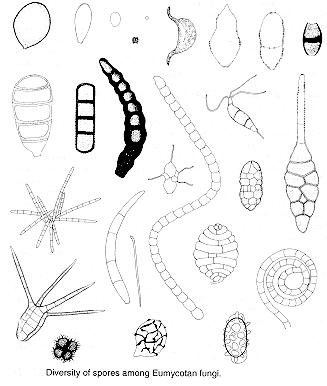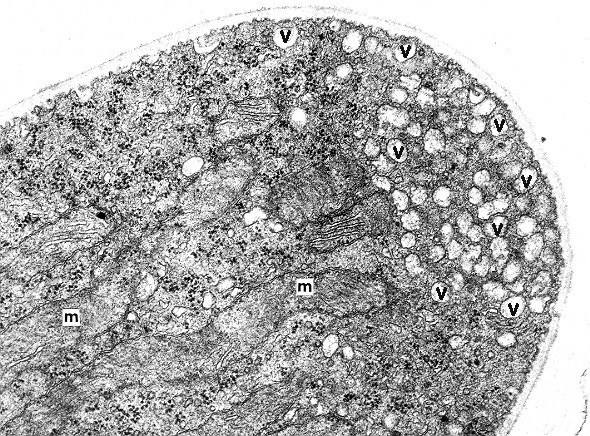The Fifth Kingdom - Chapter 3a
Eumycotan Fungi - The Mainstream
Phyla Zygomycota, Glomeromycota and the Dikarya
Earlier, I introduced the idea that the number, kind and arrangement of motility organelles (flagella) found in the chromistan and some eumycotan fungi are very basic, highly conserved features. As a corollary of this, the absence of motile cells from the life cycle of most eumycotan fungi must also be considered important. This seems to reflect a radical shift in evolutionary direction. It shows very clearly that most true fungi are basically terrestrial (landlubbers), and must have been so for a long time. Many more ecological niches and substrates are available on land than in the water, and the challenges of survival and dispersal are very different.
Fungi are heterotrophic, which means that they depend on energy-rich carbon compounds manufactured by other organisms. But this doesn't seem to have been a serious disadvantage. Fungi have evolved enzymes that can digest some extremely tough substrates. Chitin (insect exoskeletons), keratin (skin, hair, horn, feathers), cellulose (most plant debris) and lignin (wood), nourish many fungi, though cellulose and lignin remain completely unavailable to almost all animals (except with the collaboration of microbial symbionts). Their unusual ability to exploit cellulose and lignin gives some saprobic fungi almost exclusive access to the massive quantities of plant debris produced every year, and may well make them the world's number one recyclers. Only man-made plastics are, perhaps unfortunately, immune to their attacks, which means that we, not the fungi, must take responsibility for recycling these substances.
There are two major physical reasons for the
incredible success the fungi enjoy. The first is the fungal spore,
the second the fungal hypha.
Spores permit rapid dispersal and a kind of scattershot saturation of the
biosphere - fungal spores are everywhere.
Hyphae permit the thorough and intimate exploration and exploitation of
newly available substrates.
SPORES - The non-motile microscopic spores of eumycotan fungi, which come in a dazzling array of forms (below) to fit specific functions, are often produced very quickly (in a matter of days or even hours after the initial colonization of the substrate), and in enormous numbers.

Spores are dispersed
by wind, by water, or by animal
vectors,
and they can often survive long periods, sometimes even years, of
unfavourable conditions such as freezing, starvation or desiccation
(which means drying out, and is spelled with one 's', two 'c's).
Like bacteria, fungal spores are everywhere, and especially in the air
we breathe (sometimes up to 10,000 of them in a cubic metre). If you are curious about the
ways in which we describe and name these spores, zip off to
Chapter 4
and find out.
HYPHAE
- these are the vegetative, assimilative organs of most fungi.
When a spore germinates, what emerges is a hypha (sometimes more than
one hypha), which grows at its tip, and explores the microscopic world
in which it landed. The picture below shows hyphae emerging from
spores and looking for food.

In order to explore the territory properly,
hyphae must branch as they spread out. This is shown in the
drawing below.

A young
fungal colony (above), arising from a single spore (the black dot in the
middle). Its strong, waterproof, chitinous hyphae, its richly
branched growth pattern, the digestive enzymes it secretes at its
growing tips, and the hydrostatic pressures it can bring to bear - all
these make it ideally suited for actively penetrating, exploring
and exploiting solid substrates in a manner that the bacteria, chief
competitors of the fungi in the recycling business, cannot
match. (How many hyphal tips do you think there are in this
illustration of a very young colony? 176? 294?
388? 502? -- the answer is 388, and this number will double
every hour or so.
If a fungus is
growing in liquid culture or in a solid substrate and producing a
spherical colony, the rate of increase in the number of hyphal tips is
much faster, and the final number in a mature colony,
astronomical.
The transmission electron micrograph (TEM) below (from Cole and Samson 1979) shows how vesicles (v) containing new wall material or enzymes concentrate at the hyphal tip, while the energy engines of the cell, the mitochondria (m), sit a little further back. The many, many little round black dots in clusters are ribosomes, the sites of protein synthesis. Make no mistake, it is at the hyphal tip that the fungus interacts with the world outside, and where all growth in length takes place.

Fungi have learned to
cope with environmental extremes. They can grow at temperatures as low as
-5o Celsius and as high as 60o Celsius. They
include the most
xerotolerant
organisms known: some moulds will grow at the amazingly low
water activity
of 0.65 (most plants wilt permanently at a water activity of 0.98). Other
moulds grow in oxygen concentrations as low as 0.2% (air contains 20%
oxygen). Certain fungi can grow under extremely acid conditions (pH 1):
others can tolerate alkalinity up to pH 9. These topics are covered
in more detail in Chapter 20 (Food Spoilage by
Fungi and its Prevention).
As I have already noted, the saprobic fungi are recyclers par excellence, but they are also among the world's greatest opportunists, and don't restrict their attentions to naturally occurring dead wood and leaves. Where there is a trace of moisture, their omnipresent spores will germinate, and the hyphae arising from them will attack food and fabric, paper and paint, or almost any other kind of organic matter. Some of their metabolites (mycotoxins) are extremely dangerous - even carcinogenic - if they contaminate food (Chapter 21 - Mycotoxins in Food and Feed). And parasitic fungi cause the majority of serious plant diseases (Chapter 12 - Fungal Plant Pathology in Agriculture and Forestry), as well as some diseases of animals and people (Chapter 23 - Medical Mycology).
Fortunately, there is a brighter side to fungal intervention in human affairs: we have
harnessed the biochemical virtuosity of the saprobic fungi in the production of beer,
wine, bread, some gourmet cheeses, soy sauce, some antibiotics and
immunosuppressants, organic
acids, and many other useful chemicals. Fungi are even being used to convert plant waste
into high-protein animal feed. We ourselves eat a number of the large, spore-producing
structures developed by fungi: mushrooms, chanterelles, morels and truffles are all
familiar to devotees of French cuisine, who prize them for their unique flavours. Some of
the parasitic forms are now being recruited to attack insects, weeds and other fungi which
threaten our welfare (Chapter 14). And fungi in intimate, obligatory
association with the roots of almost all higher plants (forming mycorrhizas),
silently, invisibly and influentially perpetuate one of the world's oldest and most
successful forms of
mutualistic
symbiosis (Chapter 17).
Go to Chapter 3b
Go to Table of Contents
© Mycologue Publications 2020
